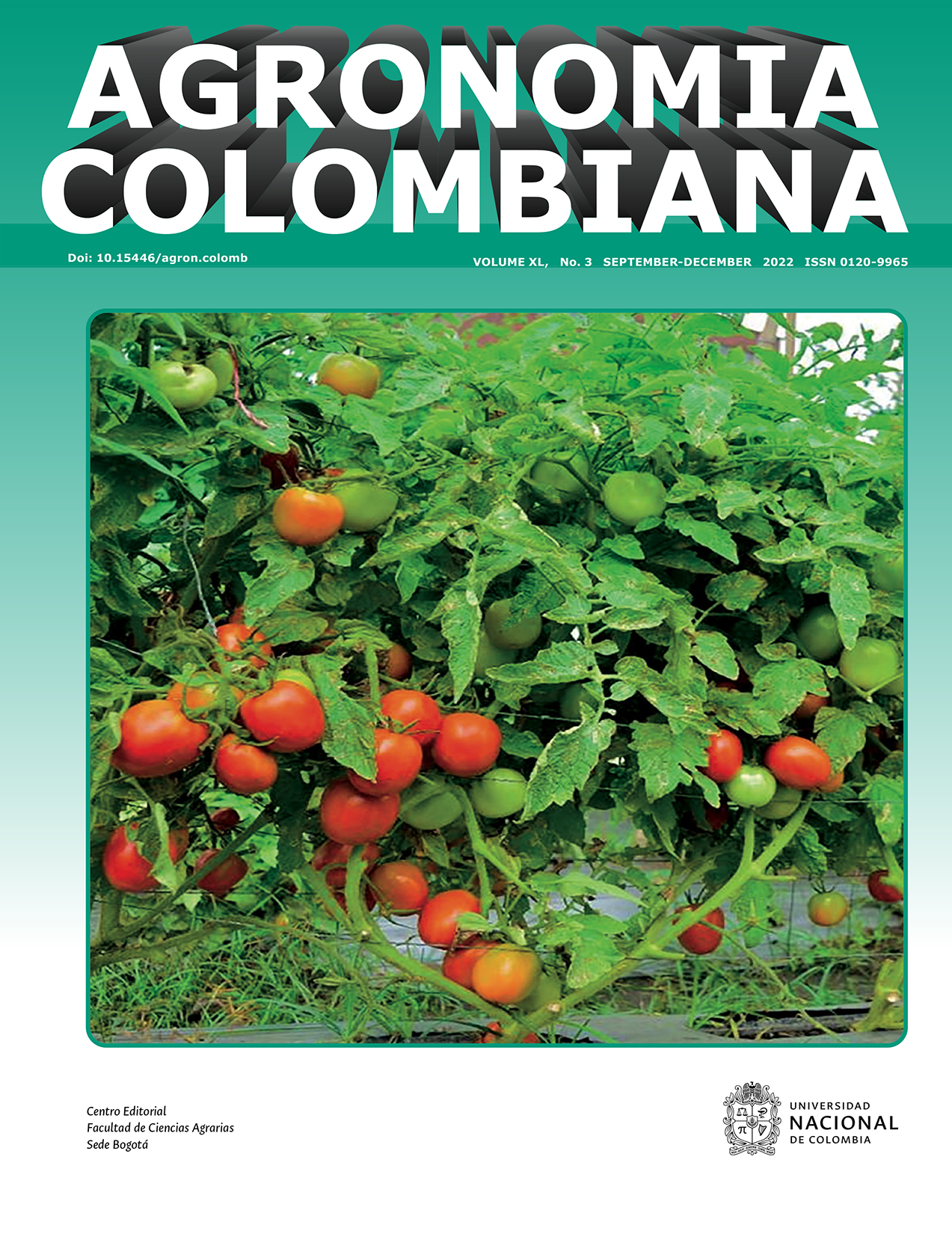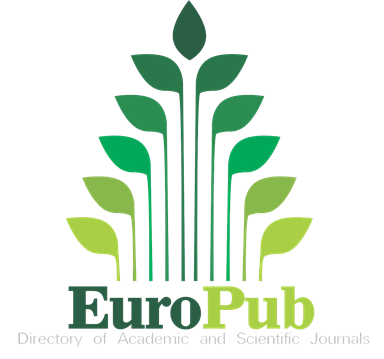Biological studies of Puccinia lantanae, a potential biocontrol agent of “Lippia” (Phyla nodiflora var. minor)
Estudios biológicos en Puccinia lantanae, posible agente de biocontrol de“Lippia” (Phyla nodiflora var. minor)
DOI:
https://doi.org/10.15446/agron.colomb.v40n3.103562Keywords:
spores, biological control, invasive species, specificity (en)esporas, control biológico, especies invasoras, especificidad (es)
Downloads
Phyla nodiflora var. minor (syn. P. canescens (Kunth) Greene) known as “lippia” is an invasive weed with considerable impact on agricultural systems and conservation areas in Australia. The rust fungus Puccinia lantanae Farl. has been proposed as a potential biocontrol agent of Lantana camara. As it was previously found in Lippia s.l. in Argentina, we aim to study: (i) its geographical distribution in Argentina, Bolivia, and Chile; (ii) teliospore germination and basidiospore formation under different incubation temperatures; (iii) the effect of teliospore age on germination capacity; (iv) the effect of heat shock on teliospore germination and basidiospore formation; and (v) the pathogenicity of the rust fungus on P. nodiflora. Field surveys were conducted in Argentina, Bolivia, and Chile. In vitro experimental assays of germination and pathogenicity were performed. The rust was found in four provinces of Argentina (Jujuy, Salta, Formosa, and Entre Rios) and was not found in Bolivia and Chile. Puccinia lantanae showed the maximum values of teliospore germination and basidiospore formation at 20°C. The effect of aging and heat shock treatments significantly reduced teliospore germination. Pathogenicity tests showed that P. nodiflora var. minor, reptans, and nodiflora were infected with the “Formosa” isolate. The isolates “Salta” and “Entre Rios” infected var. minor and reptans, being potential candidates for biocontrol.
Phyla nodiflora var. minor (syn. P. canescens (Kunth) Greene), conocida comúnmente como “lippia” es una maleza invasora que genera un grave impacto en los sistemas agrícolas y áreas protegidas en Australia. La roya, Puccinia lantanae Farl., ha sido propuesta como un potencial agente de biocontrol de Lantana camara. Este hongo fue encontrado en Lippia s.l. en Argentina; por esta razón, proponemos estudiar (i) su distribución geográfica en Argentina, Bolivia y Chile; (ii) la germinación de teliosporas y la formación de basidiosporas bajo diferentes temperaturas de incubación; (iii) el efecto de la edad de las teliosporas sobre la capacidad de germinación; (iv) el efecto del choque térmico sobre la germinación de teliosporas y la formación de basidiosporas; (v) la patogenicidad de la roya sobre P. nodiflora. Se realizaron ensayos in vitro de germinación y de patogenicidad. La roya se encontró en cuatro provincias de Argentina (Jujuy, Salta, Formosa y Entre Ríos), y no se encontró en Bolivia y Chile. La germinación de las teliosporas y la formación de basidiosporas fueron máximas a 20°C. El efecto de la edad de las teliosporas y los tratamientos de choque térmico redujeron significativamente la germinación de estas. P. nodiflora var. minor, reptans y nodiflora fueron infectadas con el aislado “Formosa”. Los aislados “Salta” y “Entre Rios”, infectaron a la var. minor y reptans siendo candidatos potenciales de biocontrol.
References
Agrios, G. N. (2005). Plant pathology. Elsevier.
Alexopoulos, C. J., Mims, C. W., & Blackwell, M. (1996). Introductory mycology. John Willey and Sons, Inc.
Anderson, F. E., López, S. P. S., Sánchez, R. M., Fuentealba, C. G. R., & Barton, J. (2016). Puccinia araujiae, a promising classical biocontrol agent for moth plant in New Zealand: biology,host range and hyperparasitism by Cladosporium uredinicola. Biological Control, 95, 23–30. https://doi.org/10.1016/j.biocontrol.2015.12.015 DOI: https://doi.org/10.1016/j.biocontrol.2015.12.015
Anikster, Y., Szabo, L. J., Eilam, T., Manisterski, J., Koike, S. T., & Bushnell, W. R. (2004). Morphology, life cycle biology, and DNA sequence analysis of rust fungi on garlic and chives from California. Phytopathology, 94(6), 569–577. DOI: https://doi.org/10.1094/PHYTO.2004.94.6.569
Barreto, R. W., Evans, H. C., & Ellison, C. A. (1995). The mycobiota of the weed Lantana camara in Brazil, with particular reference to biological control. Mycological Research, 99(7), 769–782. https://doi.org/10.1016/S0953-7562(09)80725-9 DOI: https://doi.org/10.1016/S0953-7562(09)80725-9
Cabrera, N., Sosa, A., Telesnicki, M., & Julien, M. (2016). Morphology of juvenile stages of Kuschelinabergi (Harold) with biological information (Coleoptera, Chrysomelidae, Alticini). ZooKeys. (561), Article 51. https://doi.org/10.3897/zookeys.561.5950 DOI: https://doi.org/10.3897/zookeys.561.5950
Cummins, G. B., & Hiratsuka, Y. (2003). Illustrated genera of rust fungi (3rd ed.). APS Press.
Di Rienzo, J. A., Casanoves, F., Balzarini, M. G., González, L., Tablada, M., & Robledo C. W. (2013). InfoStat version 2013. Grupo InfoStat, Universidad Nacional de Córdoba. https://www.infostat.com.ar
Earl, J. (2003). The distribution and impacts of lippia (Phyla canescens) in the Murray Darling system (Report). Agricultural Information & Monitoring Services.
Ellis, M. B. (1976). More dematiaceous hyphomycetes. Commonwealth Mycological Institute. https://doi.org/10.1079/9780851983653.0000 DOI: https://doi.org/10.1079/9780851983653.0000
Ellison, C. A., & Cortat, G. (2011). Assessment of the suitability of the rust fungus Puccinia lantanae for release as a classical biological control agent against Lantana camara in Australia (Report VM10038). CABI.
Ellison, C. A., Evans, H. C., Djeddour, D. H., & Thomas, S. E. (2008). Biology and host range of the rust fungus Puccinia spegazzinii: a new classical biological control agent for the invasive, alien weed Mikania micrantha in Asia. Biological Control, 45(1), 133–145. https://doi.org/10.1016/j.biocontrol.2007.12.001 DOI: https://doi.org/10.1016/j.biocontrol.2007.12.001
Farr, D. F., Bills, G. F., Chamuris, G. P., & Rossman, A. Y. (1989). Fungi on plants and plant products in the United States. APS Press.
Fourie, A., & Wood, A. R. (2018). The rust fungus Puccinia arechavaletae, a potential biological control agent of balloon vine (Cardiospermum grandiflorum) in South Africa. I: Biology. Australasian Plant Pathology, 47(4), 379–387. https://doi.org/10.1007/s13313-018-0569-5 DOI: https://doi.org/10.1007/s13313-018-0569-5
Gross, C. L., Fatemi, M., Julien, M., McPherson, H., & Van Klinken, R. (2017). The phylogeny and biogeography of Phyla nodiflora (Verbenaceae) reveals native and invasive lineages throughout the world. Diversity, 9(2), Article 20. https://doi.org/10.3390/d9020020 DOI: https://doi.org/10.3390/d9020020
Hernández, J. R., & Hennen, J. F. (2002). Rust fungi (Uredinales) of northwest Argentina. SIDA, Contributions to Botany, 20(1), 313–338.
Jackson, H. S. (1932). The rusts of South America based on the Holway collections—VI. Mycologia, 24(1), 62–186. DOI: https://doi.org/10.1080/00275514.1932.12020608
Julien, M., Sosa, A., Traversa, G., & Van Klinken, R. (2012). Phyla canescens (Kunth) Greene–lippia. In J. Cullen, M. Julien, & R. McFadyen (Eds.), Biological control of weeds in Australia (pp. 463–471). CSIRO Publishing. https://doi.org/10.1071/9780643104204 DOI: https://doi.org/10.1071/9780643104204
Lindquist, J. C. (1982). Royas de la República Argentina y zonas limítrofes. Instituto Nacional de Tecnología Agropecuaria.
Mercer, E. H., & Birbeck, M. S. (1972). Electron microscopy: a handbook for biologists. Blackwell Scientific.
Morin, L., Auld, B. A., & Brown, J. F. (1993). Host range of Puccinia xanthii and postpenetration development on Xanthium occidentale. Canadian Journal of Botany, 71(7), 959–965. https://doi.org/10.1139/b93-108 DOI: https://doi.org/10.1139/b93-108
Morin, L., Brown, J. F., & Auld, B. A. (1992a). Effects of environmental factors on teliospore germination, basidiospore formation, and infection of Xanthium occidentale by Puccinia xanthii. Phytopathology, 82(12), 1443–1447. https://doi.org/10.1094/phyto-82-1443 DOI: https://doi.org/10.1094/Phyto-82-1443
Morin, L., Brown, J. F., & Auld, B. A. (1992b). Teliospore germination, basidiospore formation and the infection process of Puccinia xanthii on Xanthium occidentale. Mycological Research, 96(8), 661–669. https://doi.org/10.1016/s0953-7562(09)80494-2 DOI: https://doi.org/10.1016/S0953-7562(09)80494-2
Morin, L., Neave, M., Batchelor, K., & Reid, A. (2006). Biological control: a promising tool for managing bridal creeper, Asparagus asparagoides (L.) Druce, in Australia. Plant Protection Quarterly, 21(2), 69–67. https://www.cabi.org/isc/abstract/20063166393
Munir, A. A. (1993). A taxonomic revision of the genus Phyla Lour. (Verbenaceae) in Australia. Journal of the Adelaide Botanic Garden, 15(2), 109–128.
O’Leary, N., & Múlgura, M. E. (2012). A taxonomic revision of the genus Phyla (Verbenaceae). Annals of the Missouri Botanical Garden, 98(4), 578–596. https://doi.org/10.3417/2009120 DOI: https://doi.org/10.3417/2009120
Rentería, J. L., & Ellison, C. (2004). Potential biological control of Lantana camara in the Galapagos using the rust Puccinia lantanae. SIDA, Contributions to Botany, 21(2), 1009–1017.
Sosa, A. J., Cardo, M. V., & Julien, M. H. (2017). Predicting weed distribution at the regional scale in the native range: environmental determinants and biocontrol implications of Phyla nodiflora (Verbenaceae). Weed Research, 57(3), 193–203. DOI: https://doi.org/10.1111/wre.12247
Thomas, S. E., Evans, H. C., Cortat, G., Koutsidou, C., Day, M. D., & Ellison, C. A. (2021). Assessment of the microcyclic rust Puccinia lantanae as a classical biological control agent of the pantropical weed Lantana camara. Biological Control, 160, Article 104688. https://doi.org/10.1016/j.biocontrol.2021.104688 DOI: https://doi.org/10.1016/j.biocontrol.2021.104688
Viégas, A. P. (1961). Índice de fungos da América do Sul. Instituto Agronomico.
Waller, J. M., Lenné, J. M., & Waller, S. J. (Eds.). (2002). Plant pathologist’s pocketbook (No. 632.3/W198). CABI Publishing. DOI: https://doi.org/10.1079/9780851994581.0000
How to Cite
APA
ACM
ACS
ABNT
Chicago
Harvard
IEEE
MLA
Turabian
Vancouver
Download Citation
CrossRef Cited-by
1. Esteban Charria-Girón, Aída M. Vasco-Palacios, Bibiana Moncada, Yasmina Marin-Felix. (2023). Colombian Fungal Diversity: Untapped Potential for Diverse Applications. Microbiology Research, 14(4), p.2000. https://doi.org/10.3390/microbiolres14040135.
Dimensions
PlumX
Article abstract page views
Downloads
License

This work is licensed under a Creative Commons Attribution-NonCommercial-ShareAlike 4.0 International License.
© Centro Editorial de la Facultad de Ciencias Agrarias, Universidad Nacional de Colombia
Reproduction and quotation of material appearing in the journal is authorized provided the following are explicitly indicated: journal name, author(s) name, year, volume, issue and pages of the source. The ideas and observations recorded by the authors are their own and do not necessarily represent the views and policies of the Universidad Nacional de Colombia. Mention of products or commercial firms in the journal does not constitute a recommendation or endorsement on the part of the Universidad Nacional de Colombia; furthermore, the use of such products should comply with the product label recommendations.
The Creative Commons license used by Agronomia Colombiana journal is: Attribution - NonCommercial - ShareAlike (by-nc-sa)

Agronomia Colombiana by Centro Editorial of Facultad de Ciencias Agrarias, Universidad Nacional de Colombia is licensed under a Creative Commons Reconocimiento-NoComercial-CompartirIgual 4.0 Internacional License.
Creado a partir de la obra en http://revistas.unal.edu.co/index.php/agrocol/.





















